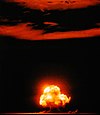Portal:History of science/Article/27

The Manhattan Project refers to the project to develop the first nuclear weapons during World War II by the United States, the UK and Canada. Formally designated as the Manhattan Engineering District (MED), it refers specifically to the period of the project from 1942 to 1946 under the control of the U.S. Army Corps of Engineers, under the administration of General Leslie R. Groves, with its scientific research directed by the American physicist J. Robert Oppenheimer.
The project succeeded in developing and detonating three nuclear weapons in 1945: a test detonation on July 16 (the Trinity test) near Alamogordo, New Mexico; an enriched uranium bomb code-named "Little Boy" detonated on August 6 over Hiroshima, Japan; and a plutonium bomb code-named "Fat Man" on August 9 over Nagasaki, Japan.
The project's roots lay in scientists' fears since the 1930s that Nazi Germany was also investigating such weapons of its own. Born out of a small research program that began in 1939, the Manhattan Project would eventually employ more than 130,000 people and cost a total of nearly $2 billion USD ($20 billion in 2004 dollars based on CPI), and result in the creation of multiple production and research sites operated in secret.
The three primary research and production sites of the project were the plutonium-production facility at what is now the Hanford Site, the uranium-enrichment facilities at Oak Ridge, Tennessee, and the weapons research and design laboratory which is now Los Alamos National Laboratory. Project research took place at over thirty different sites spread across the United States, Canada, and the United Kingdom. The MED maintained control over U.S. weapons production until the formation of the Atomic Energy Commission in January 1947.
